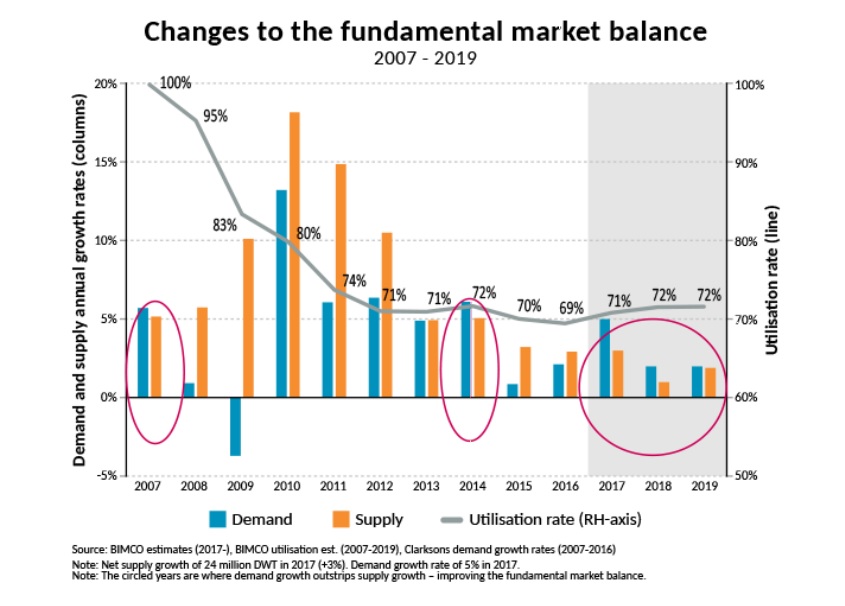In 2018, the dry bulk fleet is likely to grow at the slowest pace seen since 1999, while global demand growth could outstrip supply growth, according to BIMCO. The level of growth in the fleet and the extent of demolition of excess capacity are key factors in the 2018 market.
As the dry bulk fleet is already expected to grow at a pace that matches demand growth expected in 2019, focus must be on improving the fundamental balance ahead of this, BIMCO advised.
As explained, China’s imports, particularly of coal and iron ore, grew tremendously in 2017, and the second half of the year has been profitable for several bulk owners and operators. If 2018 delivers similar demand growth (+5%), the bulk industry will see profitable business for the full year. However, 2018 may not be quite as strong as 2017, and profits may not come around until 2019, ‘if the recovery is not handled with care’, according to BIMCO’s Chief Shipping Analyst Peter Sand.
“Unfortunately, we see weakening demolition activity, and the bulk fleet keeps growing, which can hinder market recovery. As the nominal fleet growth in 2018 is expected around 1%, focus now turns to maintaining slow steaming. If we get notably higher average ship speed the pace of recovery will slow down, if not go directly into reverse,” Mr. Sand says.
In dry bulk shipping, transported volumes follow a seasonal cycle throughout the year – first quarter volumes being the lowest and fourth quarter volumes the highest. For Q1 2018, transported volumes will be significantly lower than those of Q4 2017. It is likely that the transported volumes in Q4 2017, will not be exceeded in 2018 until Q3.
“The industry has got its work cut out to avoid a prolonged dip in freight rates during the first half of 2018 as volumes seasonally decline. Therefore, ship speed needs to be the main focus”, Sand says. “The caveat here being that we are at the mercy of China’s appetite for dry bulk commodities. China’s economic growth remains the absolute key factor for the bulk shipping market,” he says.

An unexpected market development in 2017 was China becoming even more dominant in the dry bulk sector. China grew its imports – of essentially all commodities – by a hefty margin. Some of the key reasons include, a faster substitution of China’s own low-quality iron ore towards seaborne imports of a higher quality. As well as continued strong coal imports, despite the suspension of the 276-working-days limitation.
An early indication of 2018 demand growth in Chinese iron ore imports is positive, up by 3%, whereas coal is likely to remain steady.
However, the increased fleet growth meant that the economic benefits of such a strong demand growth rate were not fully earned, added Mr. Sand.
The dry bulk industry is on the road to recovery and maintaining that recovery is now the key challenge. Recovery is achieved by targeting improvements in profitability via improvement in the fundamental balance. This is done by continued demolition activity (short-term) and careful placement of new orders (long-term).
During the third quarter of 2017, freight rates turned profitable for all sizes of dry bulk ships. This means ships deployed in the spot market have been fixed at a level covering operational expenditure, and financing costs include repayment of debt. It’s the first time since 2012 that it has happened at industry average level.
However, rates could have gone even higher, BIMCO says. At the start of 2017, there was only a slim improvement in the market (0.2%) as the demand growth rate (+2.2%) was forecasted to outstrip the fleet growth rate (+2%) by a small margin.
BIMCO now forecasts 2017 will reach a demand growth rate as high as 5% and a fleet growth of 3%, improving the fundamental market balance by 2%. Nevertheless, had the fleet growth rate remained at the initial 2%, it would have improved the market by 3%, a strong level not seen since 2004. Back then, the fundamental balance improved by 3.7% (2004: demand growth rate: 10.5% – supply growth rate: 6.8%).






























































